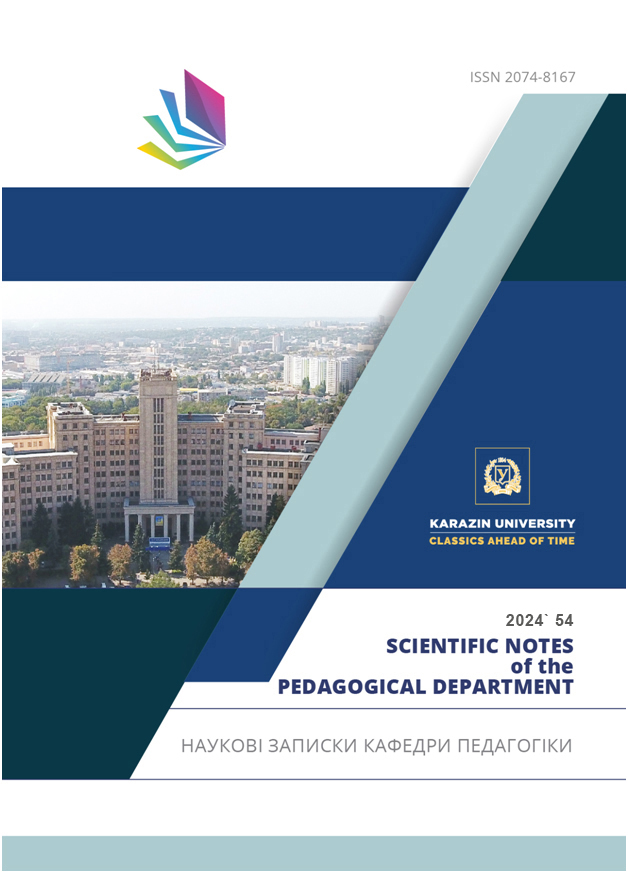Learner-centered approach to teaching foreign languages in higher education institutions
Abstract
The article identifies the main features of the learner-centered approach at the present stage of its development: a) the central idea of autonomous learning and activity of learners; b) the purpose of learning is the formation of foreign language communication skills and, at the same time, the comprehensive development of personality; c) the content of learning implies the choice of educational materials and technologies in accordance with the abilities, aptitudes, needs, interests and moral problems of the student; d) the role of the learner is crucial, characterized by maximum independence, active participation in setting goals and organizing the learning process, evaluating its results; e) the main function of the teacher is to facilitate learning activities, i. e. to create comfortable conditions for learning and comprehensive development of the individual.
Downloads
References
/References
Berezneva, I.M. and Filatova, L.S. (2022). Peculiarities of the application of the learner-centered approach to teaching foreign languages to military cadets. Abstracts of the Interuniversity Scientific and Methodological Sem- inar “From Traditions to Innovations in Teaching Foreign Languages in Higher Education Institutions”. Kharkiv: National Academy of the National Guard of Ukraine. P.15-18. URL: https://dspace.hnpu.edu.ua/server/api/ core/bitstreams/45872333-f3ce-47d8-ac26-f384929b33d7/content
Nedyal, A. (2022). Learner-centered approach in the aspect of professional competence of a language teach- er. Postgraduate pedagogical education. №1-2. P. 44-47. URL: https://znayshov.com/News/Details/pedaho- hichnyi_visnyk_1_2_2022
Romasheva, N.V. (2009). The use of learner-centered technologies in teaching foreign languages. Pedagogical Sciences. Issue 52. P. 351-355. URL: https://ps.journal.kspu.edu/index.php/ps/article/view/2091
Sukhomlynskyi V.O. Biography. - URL: https://www.ukrlib.com.ua/bio/printit.php?tid=1868.
Tarnopolsky, O.B. (2019). Methods of teaching foreign languages and their aspects in higher education: a text- book. Dnipro: Alfred Nobel University. 256 p. URL: https://ir.duan.edu.ua/items/5752b76d-14d8-46a5-970c- bc1bf54b1a61
Tarnopolsky, O.B. (2019). Three main paradigms in the teaching of foreign languages in the 21st century: prolegomena to the creation of a unified approach to their teaching. Foreign language s . 2019. No. 2. P. 3-9 DOI: https://doi.org/10.32589/1817-8510.2019.2.169307
Filipska, V.I. (2022). Personal-oriented approach during teaching of professional foreign languages. Magazine “Scientific Innovations and Advanced Technologies”. No. 11(13). P.374-381. https://doi.org/10.52058/2786- 5274-2022-11(13)-374-381
Al-Omari, T.A. and Bataineh, R.F. (2014) Jordanian EFL Teachers’ Awareness and Incorporation of Multiple Intel- ligences into Their Pedagogical Practices. Open Access Library Journal, 1: e327. DOI: http://dx.doi.org/10.4236/ oalib.1100327
Berman, M. (2002). A Multiple Intelligences Road to an ELT Classroom. 2nd edn. Carmathen: Crown House Publish- ing. URL: https://www.crownhouse.co.uk/assets/look-inside/9781899836239.pdf
Christison, M. (1998). Applying multiple intelligence theory in preservice and inservice TEFL education pro- grams. English Language Teaching Forum 36(2) (April-June). P. 3-13.
Gardner, H. (1985). Frames of Mind: The Theory of Multiple Intelligences. New York: Basic Books.
Gardner, H. (2008). Multiple Intelligences: New Horizons in Theory and Practice. Hachette UK, 2008, 2008. 320 р.
Gardner, H. (2014). Mind, Work, and Life: A Festschrift on the Occasion of Howard Gardner’s 70th Birthday. Create Space. URL: https://pz.harvard.edu/resources/mind-work-and-life-a-festschrift-on-the-occasion-of-howard- gardner’s-70th-birthday
Multiple Intelligences – URL: https://www.britannica.com/science/multiple-intelligences
Nunan, D. (1990). Learner-Centred Curriculum. Cambridge: Cambridge University Press. DOI: https://doi. org/10.1017/CBO9781139524506
Richards, J. C. and Rodgers, T. S. (2014). Approaches and Methods in Language Teaching. 3rd edn. Cambridge Uni- versity Press. 410 p.
Shaari, S., and Matore, M. E. E. M. (2019). Emphasizing the Concept of Spiritual Intelligence from Islamic and Western Perspectives on Multiple Intelligence. Creative Education, 10, 2019, р. 2815-2830. DOI: https://doi. org/10.4236/ce.2019.1012208
Sánchez Calvo, Arsenio. (2007). A Learner-Centred Approach to the Teaching of English as an L2. ES: Revista de filología inglesa, N.28, pags.189-196. URL: https://uvadoc.uva. es/handle/ 10324/17350
Teele, S. (2000). Rainbows of Intelligence: Exploring How Students Learn. Thousand Oaks, CA: Corwin Press. 184 p.
The Cambridge Handbook of Intelligence. 2nd edition. (2020). Edited by Robert J. Sternberg. Cambridge University Press. DOI: https://doi.org/10.1017/9781108770422
Березнева І. М., Філатова Л. С. Особливості застосування особистісно-орієнтованого підходу до навчання іноземної мови курсантів військових ЗВО. Тези доповідей Міжвузівського науково-методичного семінару «Від традицій до інновацій в навчанні іноземних мов у закладах вищої освіти». Харків: Національна академія Національної гвардії України, 2022. С.15–18. URL: https://dspace.hnpu.edu.ua/server/api/core/bitstreams/45872333-f3ce-47d8-ac26-f384929b33d7/content
Недял А. Особистісно орієнтований підхід в аспекті професійної компетентності вчителя-словесника. Післядипломна педагогічна освіта. 2022. №1-2. С. 44–47. URL: https://znayshov.com/News/Details/pedahohichnyi_visnyk_1_2_2022
Ромашева Н.В. Використання особистісно-орієнтованих технологій у навчанні іноземних мов. Педагогічні науки. 2009. Вип. 52. С. 351–355. URL: https://ps.journal.kspu.edu/index.php/ps/article/view/2091
Сухомлинський В.О. Біографія. URL: https://www.ukrlib.com.ua/bio/printit.php?tid=1868
Тарнопольський О.Б. Методика викладання іноземних мов та їх аспектів у вищій школі: підручник. Дніпро: Університет імені Альфреда Нобеля, 2019. 256 с. URL: https://ir.duan.edu.ua/items/5752b76d-14d8-46a5-970c-bc1bf54b1a61
Тарнопольський О.Б. Три головних парадигми у викладанні іноземних мов у XXI сторіччі: пролегомени до створення єдиного підходу до їх навчання. Іноземні мови. 2019. №2. С. 3-9. DOI: https://doi.org/10.32589/1817-8510.2019.2.169307
Филипська В.І. Особистісно-орієнтований підхід під час викладання іноземних мов професійного спрямування. Журнал «Наукові інновації та передові технології». № 11(13) 2022. С.374-381. DOI: https://doi.org/10.52058/2786-5274-2022-11(13)-374-381
Al-Omari T.A., Bataineh R.F. Jordanian EFL Teachers’ Awareness and Incorporation of Multiple Intelligences into Their Pedagogical Practices. Open Access Library Journal. 2014. 1: e327. DOI: http://dx.doi.org/10.4236/oalib.1100327
Berman M. A Multiple Intelligences Road to an ELT Classroom. 2nd edn. Carmathen: Crown House Publishing, 2002. URL: https://www.crownhouse.co.uk/assets/look-inside/9781899836239.pdf
Christison M. Applying multiple intelligence theory in preservice and inservice TEFL education programs. English Language Teaching Forum 36(2) (April-June). P. 3-13.
Gardner H. Frames of Mind: The Theory of Multiple Intelligences. New York: Basic Books, 1985.
Gardner H. Multiple Intelligences: New Horizons in Theory and Practice. Hachette UK, 2008, 2008. 320 р.
Gardner H. Mind, Work, and Life: A Festschrift on the Occasion of Howard Gardner’s 70th Birthday. Create Space, 2014. URL: https://pz.harvard.edu/resources/mind-work-and-life-a-festschrift-on-the-occasion-of-howard-gardner’s-70th-birthday
Multiple Intelligences – URL: https://www.britannica.com/science/multiple-intelligences
Nunan D. Learner-Centred Curriculum. Cambridge: Cambridge University Press, 1990. DOI: https://doi.org/10.1017/CBO9781139524506
Richards J. C., Rodgers T. S. Approaches and Methods in Language Teaching. 3rd edn. Cambridge University Press, 2014. 410 p.
Shaari, S., Matore, M. E. E. M. Emphasizing the Concept of Spiritual Intelligence from Islamic and Western Perspectives on Multiple Intelligence. Creative Education, 10, 2019, р. 2815-2830. DOI: https://doi.org/10.4236/ce.2019.1012208
Sánchez Calvo, Arsenio. A Learner-Centred Approach to the Teaching of English as an L2. ES: Revista de filología inglesa, 2007, N.28, pags.189-196. URL: https://uvadoc.uva. es/handle/ 10324/17350
Teele, S. Rainbows of Intelligence: Exploring How Students Learn. Thousand Oaks, CA: Corwin Press, 2000. 184 p.
The Cambridge Handbook of Intelligence. 2nd edition. Edited by Robert J. Sternberg. Cambridge University Press, 2020. DOI: https://doi.org/10.1017/9781108770422

